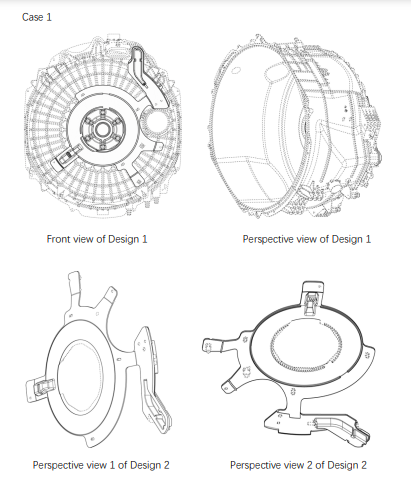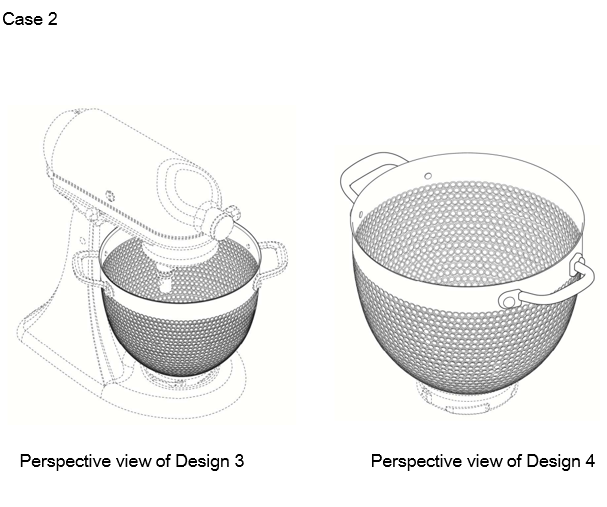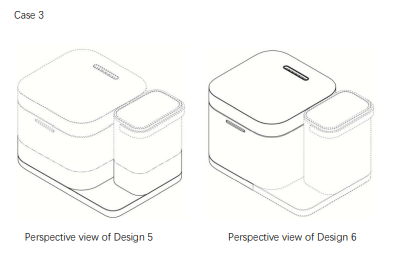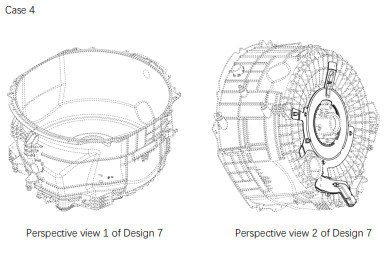The judgment of the unity of multiple partial designs has become more complicated since partial designs have been protected in China. In this article, the influence of determination of an important concept "same product" on the judgment of the unity of multiple partial designs will be briefly discussed by giving some cases.
I. Unity-related provisions and explanations
1. The new "Guidelines for Patent Examination" stipulates that:
Article 31, paragraph 2 of the Patent Law stipulates that: Multiple designs in one application should be the overall or partial designs of the same product, for example, multiple designs all are the designs of dining plates. If multiple designs are the designs of dining plates, saucers, cups, and bowls, respectively, although the dining plates, saucers, cups, and bowls belong to the same class in the “LOCARNO CLASSIFICATION”, they do not belong to the same product.
2. Normally, through overall observation, if the basic design and other design(s) have the same or similar design features and the difference between them lies in slight changes, for example, in some fine details, usual design of this category of products, the repeated and continuous arrangement of a design unit, or only colour, the other design(s) and the basic design can be considered as similar designs.
3. Related explanations
3.1 Generally, when judging whether the multiple designs are similar, determining whether they meet the requirements of “same product” in item 1 first, and then determining whether they meet the requirements in item 2.
3.2 Although the new “Guidelines for Patent Examination" do not have further detailed provisions, for partial designs, when determining whether partial designs meet the requirements of "same product" stipulated in Article 31, paragraph 2 of the Patent Law, both the overall and partial factors of the product need to be considered:
3.2.1) The overall product carriers on which the partial designs rely should be the same product; and
3.2.2) the portions claimed to be protected in partial designs are the same one portion or have common part.
In other words, only when the partial designs meet the above requirements in items 3.2.1) and 3.2.2), they can be considered as meeting the requirements of “same product” in item 1, and then there is a necessity to further determine whether they meet the requirements in item 2.
II. Case Studies
1. The overall product carriers on which multiple partial designs rely are not the same product, and thus the multiple partial designs are not similar.
Case 1

The above two designs provided by the applicant are both partial designs. Specifically, the portion to be protected in partial design 1 is a main body of a lower cover of a tub for a washing machine. That is, the portion to be protected shown by solid lines involves the major portion of the lower cover of the tub for the washing machine, and some minor details of the lower cover shown by dotted lines are not required to be protected. But for the whole design, in addition to the small details of the lower cover, the rest of the tub for the washing machine except the entire lower cover is also shown by dotted lines in the figures and are not required to be protected. For partial design 2, the portion to be protected shown by solid lines also involves a major portion of a lower cover of a tub for a washing machine, and some minor details of the lower cover are shown by dotted lines and are not required to be protected, but the rest of the tub for the washing machine except the entire lower cover is not shown in partial design 2.
Although the difference between the portions to be protected in the two partial designs is relatively small, there are no basis for similarity between the two partial designs for the following reasons:
1) According to the explanations in item 3, when judging the unity of multiple partial designs, first, it is necessary to determine whether the overall product carriers on which partial designs rely are the same product. Only when the overall product carriers on which the partial designs rely are the same product, is it necessary to determine whether the portions claimed to be protected in the partial designs are the same one portion or have common part. And when determining the overall product carriers, it is necessary to consider the overall product expressed by all lines, including dotted lines and solid lines, shown in the figures of each design.
2) In Case 1, when considering all lines including dotted lines and solid lines, the overall product carrier on which partial design 1 relies is the tub for the washing machine, and the overall product carrier on which partial design 2 relies is the lower cover of the tub for the washing machine. The tub for the washing machine and the lower cover of the tub for the washing machine are obviously not the "same product". That is, partial design 1 and partial design 2 do not meet the requirements in item 3.2.1) (and thus do not meet the requirements in item 1), and there is no basis for similarity between partial design 1 and partial design 2, which does not comply with the provisions on unity.
Accordingly, partial design 1 and partial design 2 cannot be protected in the same application.
Case 2

In the above figures, the overall product carrier on which partial design 3 relies is a stand mixer having a mixing bowl, and the overall product carrier on which partial design 4 relies is only a mixing bowl. The stand mixer having a mixing bowl and the mixing bowl are obviously not the "same product". That is, partial design 3 and partial design 4 also do not meet the requirements in item 3.2.1) (and thus do not meet the requirements in item 1), and there is no basis for similarity between partial design 3 and partial design 4, which does not comply with the provisions on unity.
Accordingly, partial design 3 and partial design 4 cannot be protected in the same application.
2. Even if the overall product carriers on which multiple partial designs rely are the same product and the portions claimed to be protected in the partial designs are the same one portion or have common part, when a difference between the multiple partial designs does not lie in slight changes, the multiple partial designs are not similar.
Case 3

The above two designs 5 and 6 provided by the applicant are both partial designs, wherein the overall products carriers on which the two partial designs rely both are a countertop cooking appliance, the portion to be protected in partial design 5 is a lower part of the countertop cooking appliance, the portion to be protected in partial design 6 is a left part of the countertop cooking appliance, and the portion to be protected in partial design 5 and the portion to be protected in partial design 6 have a common part, i.e., the lower left part of the countertop cooking appliance. That is, partial design 5 and partial design 6 meet the requirements in items 3.2.1 and 3.2.2) (and thus meet the requirements in item 1). However, the difference between the portion to be protected in partial design 5 and the portion to be protected in partial design 6 are not a minor one, which do not meet the requirements in item 2, and thus and partial design 5 and partial design 6 are not similar, which does not comply with the provisions on unity.
Accordingly, partial design 5 and partial design 6 cannot be protected in the same application.
3. The overall product carriers on which multiple partial designs rely are the same product, the portions claimed to be protected are the same one portion or have common part, and a difference between the multiple partial designs only lies in slight changes, the multiple partial designs are similar.
Case 4

Similar to partial design 1 in Case 1, the portion to be protected in partial design 7 is main body of a lower cover of a tub for a washing machine. The portion to be protected shown by solid lines involves the major portion of the lower cover of the tub for the washing machine, and some minor details of the lower cover are shown by dotted lines and are not required to be protected. But for the whole design, in addition to the small details of the lower cover, the rest of the tub for the washing machine except the entire lower cover is shown by dotted lines in the figures and also is not required to be protected. The only difference between partial design 1 and partial design 7 lies in that the main bodies of the lower covers to be protected in the two partial designs are slightly different, but the main bodies of the lower covers to be protected in the two partial designs have common part.
Therefore, the overall product carriers on which partial design 1 and partial design 7 rely are the same product, i.e. the tub for the washing machine, and the portions claimed to be protected (i.e. the main bodies of the lower covers of the tub for washing machines) in partial design 1 and partial design 7 have common part. That is, partial design 1 and partial design 7 meet the requirements in items 3.2.1) and 3.2.1), i.e. they meet the requirements in item 1; also, the difference between them lies in slight changes, i.e. they meet the requirements in item 2. Therefore, partial design 1 and partial design 7 comply with the provisions on unity.
Accordingly, partial design 1 and partial design 7 can be protected in the same application.
III. Conclusion
Although several actual cases are given above to illustrate the influence of determination of an important concept "same product" on the judgment of the unity of multiple partial designs, so that the applicant can better judge the unity before filing applications, in practice, the applicant needs to conduct a specific analysis for a specific case. If the applicant is uncertain about the unity issue before filing, the multiple designs can be filed in one design application first, and then be divided if necessary after receiving an objection of lacking the unity from the examiner.
Comment